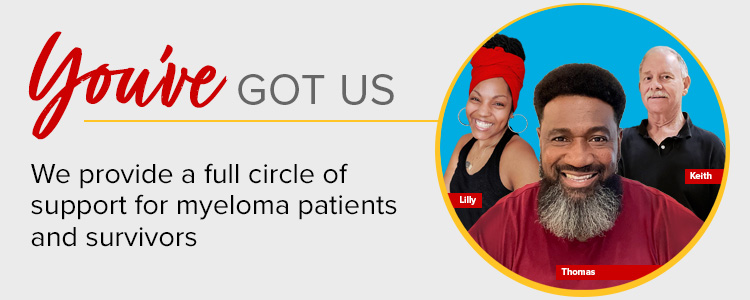Myeloma is a rare blood cancer
Let’s address the elephant in the room. Myeloma is not a skin cancer—that’s melanoma. And it’s not a bone cancer—although it can affect the bones. It’s actually one of more than 100 types of blood cancers, and in 2023 alone, approximately 35,730 cases of myeloma were expected to be diagnosed. With an estimated 157,561 people in the United States currently living with or in remission from myeloma, we know there’s an urgent need to share resources and find a cure.
Myeloma is a cancer that forms in a type of white blood cells called plasma cells. These plasma cells become abnormal and multiply, and if untreated, continue to grow and build up in the bone marrow, crowding out healthy blood cells. This can:
- Weaken the immune system
- Raise protein levels in the blood and urine, which can lead to kidney damage
- Cause build up in bone, causing it to weaken, which can lead to bone pain and fractures
- Result in death
In most myeloma patients, the disease is in multiple places in the body at the time of diagnosis. Because of that, it's often called multiple myeloma or symptomatic myeloma.
Myeloma is treatable but not curable
In many cases, myeloma is a chronic condition. It’s hard to measure the mental and emotional toll living with it takes on patients, survivors, caregivers, and families. There can be periods of remission (when the cancer is not detectible) and periods of relapse (when the cancer returns). As one survivor said about his multiple myeloma: “It’s not ‘if,’ it’s ‘when’ it comes back.” Maintaining mental health is as important as physical health, so having the advice and support of peers and experts can be a huge help.
The good news? There’s hope. Medical advances and new myeloma treatments have improved myeloma survival rates dramatically, and more are being developed every year.
- The five-year relative survival increased from 24% in 1975 to 60% by 2018.
- The 3-year survival rate as of Jan 1, 2019, was 69% for all races and ethnicities.
Five myeloma “myths”
1. Myeloma can break your bones. TRUE.
This disease weakens your bones, making them easy to break.
2. You can have myeloma and not know it. TRUE.
In early stages you might not have any symptoms, or they may be so mild that you brush them off—symptoms like weakness, fatigue, frequent infections, changes in urination frequency, loss of appetite or weight, thirst, or even a broken bone. This is called smoldering myeloma.
3. Myeloma only happens to older people. FALSE.
Most people who develop myeloma are over 60, but myeloma can also occur in younger people.
4. Once diagnosed, your dreams and future are on hold. FALSE.
Myeloma can often be treated and controlled, and, because of medical advances, many survivors are living longer lives.
5. There’s a racial and age gap among myeloma patients and survivors. TRUE.
While anyone can be diagnosed with myeloma, it occurs most often in people over 60, more males than females, and Black Americans are twice as likely to be diagnosed with myeloma as white Americans.
What’s important to remember is that there’s a broad spectrum of symptoms, disease progression is different for everyone, and—thanks to science—there’s always hope.
LLS is here for myeloma patients & caregivers
Research
LLS is a leader in myeloma-related research, investing $51.5 million across 51 research grants in our current myeloma portfolio. In fact, LLS supported 2 out of the 3 myeloma drugs the FDA approved in 2023. And we’re just getting started, looking at myeloma from all angles. Our funding is helping to identify specific genes that cause myeloma and new ways to treat them, developing new ways to arm a patient’s own immune system to keep their myeloma in check, and even studying the role of certain gastrointestinal bacteria in myeloma. It may be possible that by eradicating certain bacteria from their guts, we can stop people with a myeloma precursor condition from developing full-blown myeloma at all.
“With the number of new therapies and supportive methods to treat myeloma rapidly increasing, the hope is we can increase the duration of disease control for even more patients and get them to cures in the future.” - Lee Greenberger, LLS Chief Scientific Officer
Education & Support
LLS is committed to advocating for and providing access to care for every myeloma patient. As Black Americans are at twice the risk for myeloma as white Americans, we created Myeloma Link to increase access to education and treatment for myeloma in Black American communities. And we encourage Healthcare professionals to refer their myeloma patients to LLS for the additional information and resources they need.
And we make FREE information, education, and support accessible to patients, survivors, and caregivers—whether it’s through a phone call, online chats, a webcast or podcast, or our website (including a myeloma-specific booklet and guide for patients and caregivers).
Here are a few additional places to get started:
- Personalized support from Information Specialists, highly trained oncology social workers and nurses, who will listen to your concerns, answer your questions, and assist through treatment, financial and social challenges
- Accessing clinical trials with Nurse Navigators, who will speak to you about clinical trials and other treatment options specific to your unique situation, and personally guide you or your loved one through the entire clinical trial process
- Nutrition consultations with our registered dietitians who provide oncology nutrition education
If you’ve been touched by myeloma, you’ve got us—for dedicated myeloma research, resources, and support. And with your help, we can keep discovering more and better myeloma treatments and help even more patients and survivors.
